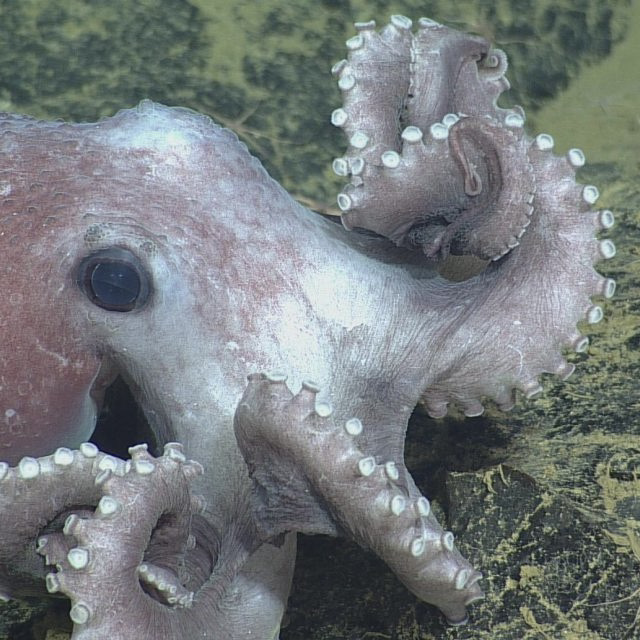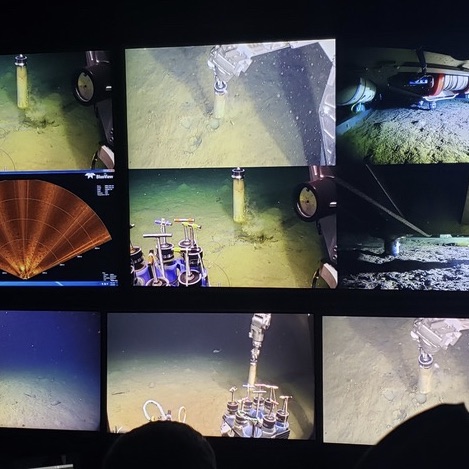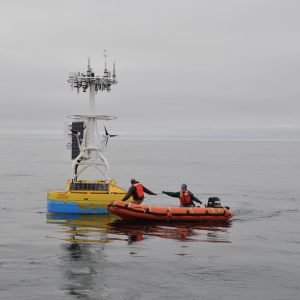Expeditions
Live Video from Regional Cabled Array Expedition
Don’t miss this rare opportunity to participate in a research cruise from aboard the ship and below the surface. Live video is being broadcast from the Regional Cabled Array’s eighth Operations and Maintenance expedition aboard the R/V Thomas G. Thompson. It is really an extraordinary way to watch first-hand the complexity of the operation involved in keeping a network of 900 kilometers of electro-optical cables supplying unprecedented power, bandwidth (10 Gigabit Ethernet, and two-way communication to scientific sensors on the seafloor and throughout the water column, so data are continuously collected and research conducted. Bookmark these links and tune in often!
Streaming live video from the ship and from the ROV ROPOS.
 Credit: NSF-OOI/UW/CSSF.[/caption]
Credit: NSF-OOI/UW/CSSF.[/caption]
Read More
Live Video from Regional Cabled Array Expedition
For the month of August, you can be a scientist aboard the R/V Thomas G. Thompson Regional Cabled Array expedition and explore the ocean floor and biologically-rich waters of the northeastern Pacific Ocean in real-time. A livestream is being broadcast of onboard activities and from the ROV, as it recovers and deploys instrumentation to maintain the Regional Cabled Array. Bookmark this livestream link and during August you can experience life and science at sea.
Please note: The livestream video is transmitted from the ship to a satellite, then to shore. Occasionally, the land-based down-link system goes down and depending on the ship’s heading, there may be an intermittent pause in the satellite connection. If the screen is blank or you see an error code, please check back soon as the connection should refresh shortly.
Read More
Science Team Heads to Blustery Irminger Sea
Ten scientists from Woods Hole Oceanographic Institution (WHOI) will board the R/V Neil Armstrong on 8 August 2020 for about a month-long expedition to OOI’s Irminger Sea Array. The journey includes an eight-day transit to reach the array, where they will recover and replace ocean observing equipment that has ridden out arduous conditions in a region known for intense winter wind events (peak speeds of 50-55 knots).
[media-caption path ="https://oceanobservatories.org/wp-content/uploads/2020/08/Irminger-Deck-Plan-small-scaled.jpg" link="#" title="Iminger Deck] Aerial view of the R/VNeil Armstrong deck with equipment loaded for an OOI Irminger Sea Array service cruise. Credit: Drone footage by James Kuo © Woods Hole Oceanographic Institution[/media-caption]Iceland is separated from the east coast of Greenland by the Denmark Strait, roughly a distance of some 250 miles. The Irminger Sea is south of the strait, stretching from Iceland down to the latitude of Cape Farewell at Greenland’s southern tip. This region is important to the Atlantic Ocean circulation and sensitive to global climate change.
Supported by wind power and solar cells, the Irminger Sea Array consists of moorings that serve as home for sensors that measure air-sea fluxes of heat, moisture and momentum, and physical, biological and chemical properties throughout the water column. The observations of the moorings are enhanced by open-ocean gliders that sample within and around the triangular array. The subsurface mooring data is also collected by the gliders via acoustic modem. The gliders then relay the collected data, glider sampling and mooring data, to shore via satellite telemetry each time they surface. Gliders also sample the upper water column near the Apex Profiler Mooring to complement the moored profiler data and extend coverage to the air-sea interface.
This month-long expedition is the seventh time the OOI team has traveled to the array, specifically to replace and repair equipment that is vital to maintaining a continuous flow of data from this important site.
“This is a difficult region to sustain surface observations, yet such observations are critical to improving our understanding of air-sea exchanges and deep convection that drives the Atlantic overturning circulation” said Al Plueddemann, project scientist for the OOI Coastal and Global Scale Nodes (CGSN).
WHOI Research Scientist Sebastien Bigorre will serve as the chief scientist for the expedition.
COVID Complications
The scientific party went into a 14-day quarantine on 21 July to ensure that everyone could safely board the ship. They were tested for COVID-19 prior to quarantine and will be tested again prior to departure. Masks and social distancing will be practiced onboard until another two-week period of health is achieved. At that point, mask wearing may be loosened as the scientific team and crew members will, in effect, be their own social bubble as they live, work, and share the space of the 238 foot-long vessel.
[media-caption path="https://oceanobservatories.org/wp-content/uploads/2020/08/DSC_0016_allison-scaled.jpeg" link="#" title="crew deploys a near surface instrument frame to the array"]During a past expedition to the Irminger Sea Array, the crew deploys a near surface instrument frame to the array. Credit: Alison Heater © Woods Hole Oceanographic Institution[/media-caption]Explained Derek Buffitt, program manager for the Coastal and Global Scale Nodes, operated from Woods Hole Oceanographic Institution, which includes oversight of the Irminger Sea Array, “COVID-19 created plenty of new logistical challenges for an expedition of this length and distance. We had to address contingencies such as what to do if someone presented COVID symptoms while at sea. WHOI’s marine operations office, working with agents and government representatives, confirmed health and safety protocols within the foreign ports along the planned vessel track. This was to ensure our personnel could receive the care needed in an emergency and in a timely manner.”
Such contingencies were necessary steps, in addition to many months of preparation, to ensure the equipment to be deployed is ready, tested, and packaged for transporting to the ship.
Watch this space, and social media, as we follow along on this important expedition.
Read MoreTeam Headed to Pioneer Array
After ten weeks of preparation, two weeks of isolation, documentation of negative COVID-19 tests, temperatures taken, and personal protective gear in place, nine science team members from Woods Hole Oceanographic Institution (WHOI) will depart on the R/V Neil Armstrong from Woods Hole, MA on Sunday 7 June 2020 for an 11-day expedition to service the Pioneer Array, a collection of ocean observing equipment off the New England coast, about 75 nautical miles south of Martha’s Vineyard.
The Pioneer mission is the first science expedition to leave Woods Hole following a “pause” in research expeditions imposed in March by UNOLS (University-National Oceanographic Laboratory System). UNOLS coordinates the U.S. academic research fleet ship schedules and has established guidelines for COVID prevention and mitigation aboard these ships. The journey aboard the R/V Neil Armstrong is the second UNOLS science expedition to leave port with new stringent COVID-prevention protocols in place.
“We’ve worked extremely hard to implement measures that will help ensure the safety and health of our scientific party and crew members aboard the R/V Neil Armstrong,” said Al Plueddemann, chief scientist for the Pioneer Array expedition and a research scientist at WHOI. “It’s been an extensive planning and re-planning effort as our procedures had to adapt to changing circumstances.”
“We’ve had to reduce our scientific team significantly to ensure there is enough social distancing room aboard the ship, and condense the work into one cruise leg instead of two, which forced us to scale back the scientific mission, as well. But with the extensive precautionary measures in place, we are able to provide much needed service to the array, while also ensuring the cruise is sufficiently low risk to all personnel involved.”
The Pioneer Array is a collection of long-term oceanographic observing equipment that provides continuous ocean measurements over a period of years. The data collected are sent via satellite to a network server on shore for use by scientists, educators, and others. The data are available for everyone to use in as near real-time as possible. These long time-series data are helping to advance ocean research, understanding of ocean processes, and the changing ocean. The equipment requires regular maintenance to ensure that it can continually collect and disseminate biological, physical, and chemical ocean observations for the the oceanographic community and others who have come to rely on it. The Pioneer Array is one of five ocean observing arrays collecting real-time ocean data as part of the National Science Foundation funded Ocean Observatories Initiative.
Extensive precautionary measures were necessary to enable the ship and its passengers to conduct the science mission safely during the COVID-19 pandemic.
“Preparations began with trying to figure out the appropriate length and circumstances under which the scientific party and crew members could quarantine prior to heading out to sea, then evolved into gaining access to COVID-19 testing and labs to process the results, determining how to house the scientific party while in quarantine and onboard the vessel, and defining social distancing and protective gear that would be needed while at sea,” said Derek Buffitt, program manager for the Coastal Global Scale Node arrays, which includes the Pioneer Array.
Once such decisions were made, other practical considerations were tackled, such as how to:
- store used personal protective gear while at sea for onshore disposal,
- arrange bunks to minimize shared space,
- feed passengers and maintain social distances in shared common spaces,
- maintain the operational safety of the smaller science party,
- prioritize the scientific objectives to ensure the most effective use of the ship time, and
- respond if someone presented COVID-19 symptoms while at sea.
“The Pioneer expedition departure on Sunday will represent the successful culmination of preparations for the new normal of conducting research at sea during a pandemic,” added Plueddemann.
Read More

